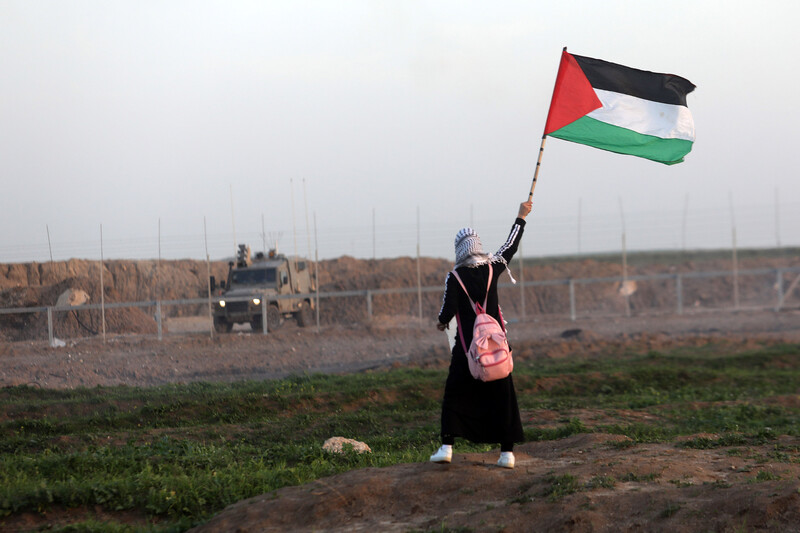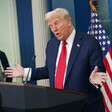Media Watch 7 March 2019

Occupation forces monitor a young Palestinian demonstrator along the Gaza boundary.
The New York Times has told me it is perfectly content to accept the word of the Israeli government over the facts.
I had advised the newspaper of record that columnist Bret Stephens misrepresented the facts in his implicit rejoinder to Michelle Alexander’s incisive opinion piece calling to break the silence on Palestine.
Stephens wrote: “Nearly 1,300 Israeli civilians have been killed in Palestinian terrorist attacks in this century: That’s the proportional equivalent of about 16 September 11s in the United States.”
This is wrong.
According to the Israeli human rights group B’Tselem, which keeps meticulous statistics, 823 Israeli civilians were killed from 29 September 2000 until the end of January this year, along with 433 “Israeli security force personnel.”
In the same period, nearly 10,000 Palestinians have been killed by Israel – the equivalent of dozens of September 11s, to use Stephens’ yardstick – although for him, Palestinian casualties apparently don’t matter at all.
Rather than correct or vigorously look into the erroneous information presented by their anti-Palestinian columnist, op-ed editor James Dao wrote me that Stephens got his “information from the Israeli government, and I’m fine with that.”
I’m not at all fine with this. Passing false Israeli government information to the public as truth is propaganda, not journalism or legitimate commentary.
Stephens is entitled to his own opinions, but he is not entitled to his own facts. Nor is the Israeli government. The word of the Israeli government – and of Bret Stephens – should be tested against real data.
In this instance, we’re not only being lied to, but told: All Palestinian fighters are terrorists and all Israelis – even armed occupation soldiers – are civilians.
The newspaper, which is rightly willing to contradict the lies of President Donald Trump, is in this instance taking quite a different approach to the lies of Prime Minister Benjamin Netanyahu’s government.
Dramatic decline
This is dangerous. And it undercuts the credibility of a newspaper I have long challenged to do better.
The failure to correct represents a dramatic decline from when I spoke nearly 14 years ago to New York Times public editor Daniel Okrent.
There is less recourse now than there was then with the newspaper no longer having an ombudsman to whom readers can turn.
I cannot know for certain, but I think Okrent would be troubled by the outsourcing of “fact-checking” to the Israeli government.
Stephens is a partisan. And he plays to anti-Palestinian racism. His credibility was shot – or should have been – when he wrote of a “Palestinian blood fetish.” That’s vile and clear-cut bigotry against the Palestinian people.
Strikingly, he makes a similarly broad statement in his recent Sunday article when he pushes back against progressives who are increasingly concerned about Israel’s discriminatory policies: “All of this is profoundly unsettling to a Jewish community that has generally seen the Democratic Party as its political home.”
This is an anti-Semitic generalization by Stephens. Not everyone in the Jewish community thinks as Stephens claims. American Jews are not monolithic when it comes to efforts to secure Palestinian rights and freedom.
Many Jews oppose Israeli occupation and other crimes, and are deeply troubled by ongoing attacks by members of the Israel lobby against women of color speaking out for Palestinian rights.
Moreover, many Jews reject Israel’s official state ideology, Zionism, as settler-colonialism and apartheid. Beyond the concerns raised by Jewish Voice for Peace about Zionism, anti-Zionist Jewish groups include Neturei Karta and the Satmar Hasidim, the largest Hasidic sect in the United States.
Letters in place of agreed fact
Rather than issue a correction, Dao suggested I write a letter instead. But that was my first response before even turning to him.
The letter was not published. Nor would it have been an entirely acceptable outcome. A correction from the newspaper carries far more weight than the opinion of a letter writer.
More than a decade ago The New York Times Magazine took a similar approach and insisted I write a letter about an error regarding the location of the Israeli barrier and the fact that in many places it does not separate Israel from the occupied West Bank but the West Bank from the West Bank.
Meanwhile the magazine did issue one rather insignificant correction about the article, noting that a photo caption “misidentified a piece of equipment on a road near the structure. It was an Israeli military vehicle, not a tank.”
This “correction” even asserted that the article it related to was about the “controversial barrier being built to separate Israel from the West Bank.” In other words, the “correction” contains a worse error than the one it is purportedly correcting.
The newspaper, as reported, has since made the same error and failed to correct it notwithstanding numerous requests.
Reporter Russell Goldman wrote in March 2017: “The elusive British street artist Banksy has decorated the interiors of the Walled Off Hotel, a nine-room guesthouse in the West Bank city of Bethlehem whose windows overlook the barrier that separates the territory from Israel.”
Once again The New York Times should be describing a barrier that largely separates Palestinians from each other and from their own land within the occupied West Bank.
The location of the barrier and the fact that many Israelis killed have not been civilians but military occupation forces are pieces of information that can be easily verified.
That The New York Times refuses to correct Stephens, placing unquestioning trust in the assertions of Israeli officials, indicates that Stephens has been provided too much space to advance Israel-related propaganda.
I don’t believe Dao harbors the same anti-Palestinian animus that Stephens does – and even Stephens on Friday criticized Netanyahu’s “demagogic attacks on Israeli Arabs” though he couldn’t bring himself to call them Palestinian citizens of Israel or express an iota of alarm about the occupation and Netanyahu’s war crimes in Gaza and the West Bank.
But relatively mild criticism of Netanyahu cannot mitigate gross errors of fact, racist slurs and indulgence of Israeli human rights abuses as Stephens has done over his career.
With this track record, Dao should not accept the word of Stephens – and the Israeli government – over that of a credible human rights organization.
The New York Times should issue a correction at the end of Stephens’ next column making clear that the Israeli government provided the erroneous information and that fact-checkers did not seek out more reputable sources of information.





Comments
proportional deaths
Permalink tom hall replied on
“Nearly 1,300 Israeli civilians have been killed in Palestinian terrorist attacks in this century: That’s the proportional equivalent of about 16 September 11s in the United States.”
The author is right to point out the double lie in this statement. But there's a third methodological tier of dishonesty in that construction. The tactic of claiming losses of life "proportional" to a much larger society is in itself problematic. It's founded on the proposition that some lives count for more than others. In this instance, if we take a base line of 3000 deaths in the September 11th attacks, and multiply that figure- as we're advised to do- by a factor of sixteen, we come to a total of 48,000 dead American civilians. So 1,300 dead Israelis takes on the equivalent value of 48,000 American lives. Why we should be using this formula isn't explained by Stephens. But I suggest that it indicates a predisposition to inflate the moral significance of Israeli Jewish lives over the lives of others. Which pretty much goes to the heart of the problem.
the facts
Permalink Carol Scheller replied on
A respected and respectable newspaper like The New York Times owes correct and corrected information to its readers, at the risk of becoming less respected if it fails to do so.
the Paper of Record
Permalink Carl Zaisser replied on
"...respectable..."? well, that's the myth, anyway...but regarding Palestine, never
And they say the West has no caste system
Permalink Kiers replied on
it's almost like a schoolyard pettyness: as if to say "these deaths are like the deaths of high class people, and those..." etc etc. what a caste system.
NYT this is beneath you.
Permalink Anonymous replied on
NYT this is beneath you.
"Free Press "
Permalink Nestor Makhno replied on
I have no trust in any newspaper in the west whatsoever. They call it "free press" but it all paid and manipulated by governments.
In the past it was possible to send comments to online newspapers in the Netherlands. They finished that because the comments wee to critical for them. If the German press appears a biased article about Palestine the possibility to comment is closed. It is all manipulation and brainwashing
manufacturing consent
Permalink Carl Zaisser replied on
We can be shocked but not surprised by the cavalier response of Dao....Chomsky would point out that in manufacturing consent, the mainstream pushes all other voices to the margin so they do not interfere with the message wanted.